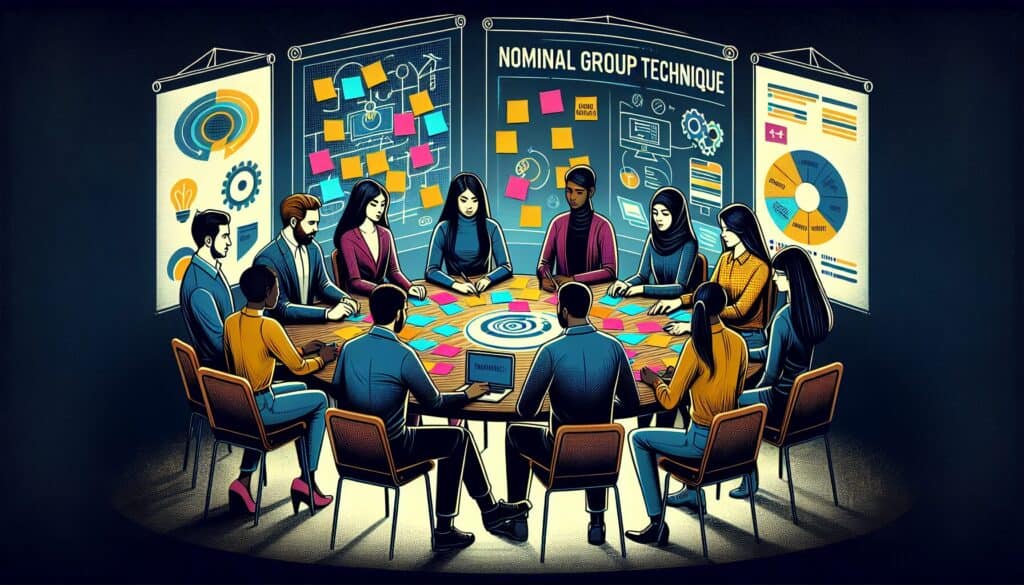To generate and prioritize ideas or solutions from a group in a structured way that encourages equal participation.
- Metodologías: Ingeniería, Calidad
Técnica de grupo nominal

Técnica de grupo nominal
- Lluvia de ideas, Mejora continua, Colaboración multifuncional, Pensamiento de diseño, Ideación, Innovación, Trabajo en equipo, Diseño centrado en el usuario, Propuesta de valor
Objetivo:
Cómo se utiliza:
- Participants individually generate ideas in writing, then share them one by one in a round-robin format. Ideas are discussed, and then participants individually rank or vote on the ideas to prioritize them.
Ventajas
- Ensures all members contribute; reduces dominance by a few individuals; provides a structured and efficient way to reach a group consensus.
Contras
- Can be more time-consuming than unstructured brainstorming; may feel restrictive to some participants; the quality of outcomes depends on the clarity of the problem statement.
Categorías:
- Ideación, Resolución de problemas, Gestión de proyectos
Ideal para:
- Generating and prioritizing ideas from a group while ensuring balanced participation.
Nominal Group Technique (NGT) finds utility across various industries such as healthcare, technology, education, and product design, particularly during the early phases of innovation and project development when teams seek to harness diverse perspectives and prioritize concepts. This structured approach can be particularly beneficial during brainstorming sessions held to identify new products, features, or improvements to existing offerings. Participants, typically comprising a cross-functional team including engineers, designers, market analysts, and stakeholders, engage in a round-robin format which serves to level the playing field, ensuring that quieter members have an opportunity to voice their ideas without being overshadowed by more dominant personalities. The emphasis on anonymity in the initial idea generation phase minimizes peer pressure, allowing for a broader range of thoughts that might otherwise remain hidden in traditional brainstorming settings. Following the sharing of ideas, the subsequent discussion phase allows participants to seek clarification, build upon suggestions, and refine their understanding before voting on the proposed solutions, which leads to the identification of those with the highest consensus among the group. This technique not only promotes collaboration but also results in actionable outcomes that have been synthesized from group input, making it suitable for complex desafíos de diseño where stakeholder buy-in is critical to the success of the project. Furthermore, NGT can be effectively employed in strategic planning sessions and focus groups, facilitating a democratic process that prioritizes ideas based on collective agreement, thereby paving the way for innovative breakthroughs in product development and organizational strategy.
Pasos clave de esta metodología
- Participants generate ideas individually in writing.
- Ideas are shared one by one in a round-robin format.
- Each idea is discussed and clarified by the group.
- Participants individually rank or vote on the ideas.
- The rankings are tallied to prioritize ideas.
Consejos profesionales
- Encourage participants to draft multiple ideas initially, as this can stimulate deeper thinking and prevent fixation on a single concept during discussion.
- Use anonymous voting methods for ranking to minimize bias and influence from dominant personalities, leading to more honest feedback.
- Implement time limits for each stage—idea generation, discussion, and voting—to maintain a dynamic pace and maximize engagement from all participants.
Leer y comparar varias metodologías, recomendamos el
> Amplio repositorio de metodologías <
junto con otras más de 400 metodologías.
Sus comentarios sobre esta metodología o información adicional son bienvenidos en la dirección sección de comentarios ↓ , así como cualquier idea o enlace relacionado con la ingeniería.
Contexto histórico
1960
1980
1983
1990
1995
2000
2010
1950
1980
1980
1986
1994
1995
2000
(si se desconoce la fecha o no es relevante, por ejemplo "mecánica de fluidos", se ofrece una estimación redondeada de su notable aparición)














Publicaciones relacionadas
Calculadora de METS a calorías
Metaanálisis
Asignación de mensajes
Diagramas de modelos mentales
Fuerzas de empuje y tracción máximas admisibles
Planificación de necesidades de material (MRP)